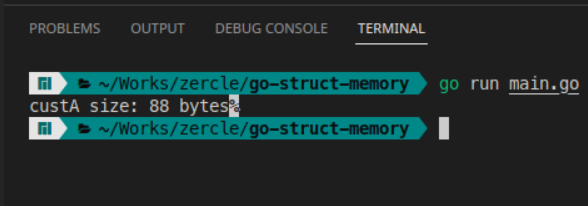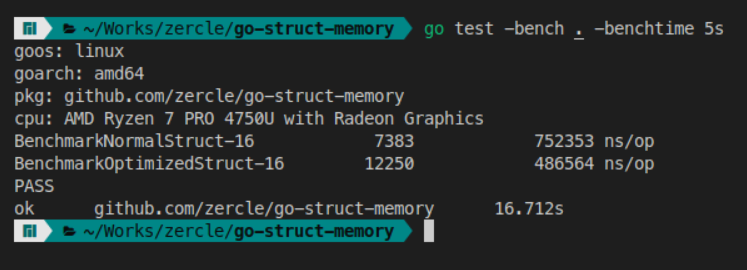Designing Go structs with knowledge of Computer Architecture and Data Structures

When I was studying computer engineering, a question that always came up was why we needed to study subjects like Computer Architecture and Data Structures. It wasn’t until I graduated and started writing in Go that I realized why Go has data types with specific sizes, such as int8, int16, int32, int64, and others. Why not just have int or number like in lazy languages like TypeScript? It was only after reading about sizes in Go that I realized we can use our knowledge of Computer Architecture and Data Structures to help us write Go code that is as efficient as it should be.
Reviewing System Architecture Knowledge
Word size
Word size is the amount of data that a CPU’s registers can store and process in one cycle, which varies depending on the CPU architecture.
- 32-bit has a word size of 4 bytes.
- 64-bit has a word size of 8 bytes.
Memory allocation
Memory allocation is the reservation of space in memory. This involves reserving the actual space needed plus additional space to fill up the word size.
Sizes of Data Types in Go
In Go, each data type has a different memory size. You can check this with unsafe.Sizeof().
Go struct
A Go struct is a way to create a data structure in Go, for example:
type Customer struct {
Id uint64 // 8 bytes
FaceId uint32 // 4 bytes
Name string // 16 bytes
Age uint8 // 1 byte
Address string // 16 bytes
PhoneId uint16 // 2 bytes
PassportId string // 16 bytes
IsActive bool // 1 byte
}
The total size of all the types in the struct is 64 bytes. Let’s see how much memory the entire struct takes up.
cusA = Customer{}
fmt.Printf("custA size: %d bytes\n", unsafe.Sizeof(custA))
The result is 88 bytes. What happened? Let’s take a look.
| word / byte | 1 | 2 | 3 | 4 | 5 | 6 | 7 | 8 |
|---|---|---|---|---|---|---|---|---|
| word 1 | Id | Id | Id | Id | Id | Id | Id | Id |
| word 2 | FaceId | FaceId | FaceId | FaceId | ||||
| word 3 | Name | Name | Name | Name | Name | Name | Name | Name |
| word 4 | Name | Name | Name | Name | Name | Name | Name | Name |
| word 5 | Age | |||||||
| word 6 | Address | Address | Address | Address | Address | Address | Address | Address |
| word 7 | Address | Address | Address | Address | Address | Address | Address | Address |
| word 8 | PhoneId | PhoneId | ||||||
| word 9 | PassportId | PassportId | PassportId | PassportId | PassportId | PassportId | PassportId | PassportId |
| word 10 | PassportId | PassportId | PassportId | PassportId | PassportId | PassportId | PassportId | PassportId |
| word 11 | IsActive |
optimized
We can see that there is padding in each word. We can optimize this like so:
type CustomerOptimized struct {
Id uint64 // 8 bytes
Name string // 16 bytes
Address string // 16 bytes
PassportId string // 16 bytes
FaceId uint32 // 4 bytes
PhoneId uint16 // 2 bytes
Age uint8 // 1 byte
IsActive bool // 1 byte
}
custA := Customer{}
fmt.Printf("custA size: %d bytes\n", unsafe.Sizeof(custA))
custB := CustomerOptimized{}
fmt.Printf("custB size: %d bytes\n", unsafe.Sizeof(custB))
Let’s see the results before and after.
Done! We got 64 bytes. The memory layout looks something like this:
| word / byte | 1 | 2 | 3 | 4 | 5 | 6 | 7 | 8 |
|---|---|---|---|---|---|---|---|---|
| word 1 | Id | Id | Id | Id | Id | Id | Id | Id |
| word 2 | Name | Name | Name | Name | Name | Name | Name | Name |
| word 3 | Name | Name | Name | Name | Name | Name | Name | Name |
| word 4 | Address | Address | Address | Address | Address | Address | Address | Address |
| word 5 | Address | Address | Address | Address | Address | Address | Address | Address |
| word 6 | PassportId | PassportId | PassportId | PassportId | PassportId | PassportId | PassportId | PassportId |
| word 7 | PassportId | PassportId | PassportId | PassportId | PassportId | PassportId | PassportId | PassportId |
| word 8 | FaceId | FaceId | FaceId | FaceId | PhoneId | PhoneId | Age | IsActive |
| word 9 | ||||||||
| word 10 | ||||||||
| word 11 |
We saved 3 words!
benchmark
Let’s see how much of a difference it makes.
| iteration (round/5s) | exec time (ns/op) | |
|---|---|---|
| Normal struct | 7,383 | 752,353 |
| Optimized struct | 12,250 | 486,464 |
fieldalignment
So, do we have to arrange our structs ourselves? The answer is yes, but we have a convenient tool for that: govet/fieldalignment. Here’s how to use it:
go install golang.org/x/tools/go/analysis/passes/fieldalignment/cmd/fieldalignment@latest
fieldalignment -fix ./...
Finally, don’t forget to always arrange your Go structs and use data types only as needed (using a fieldalignment in a pre-commit script is also convenient).


